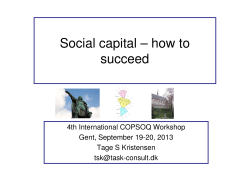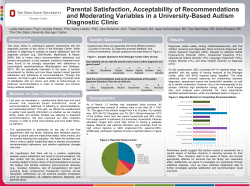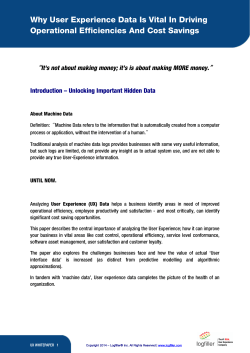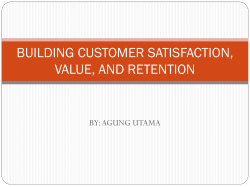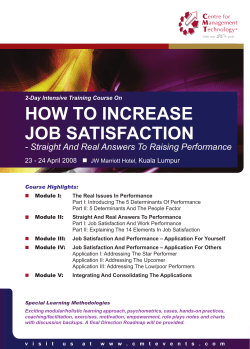
Kano’s Model of Customer Satisfaction How to Delight Your Customers
Kano’s Model of Customer Satisfaction How to Delight Your Customers A. Nitipan Ratanasawadwat Assumption University of Thailand Origins of the Kano Model Noriaki Kano Professor at Tokyo Rika University International Consultant Received individual Demming Prize in 1997 Introduction • Product/service quality is main antecedent of customer satisfaction (Cronin & Taylor 1992; Anderson & Sullivan 1993; Brady et al. 2002) • Important to find out how each attribute performance impacts on satisfaction • Prof. Kano pointed out that not all product/service attributes have same role in satisfying customer needs Origins of the Kano Model • Developed foundation for an approach on “Attractive Quality Creation” commonly referred to as the “Kano Model” • Challenged traditional Customer Satisfaction Models that More is better, i.e. the more you perform on each service attribute the more satisfied the customers will be Origins of the Kano Model Proposed new Customer Satisfaction model (Kano Model) Performance on product and service attributes is not equal in the eyes of the customers Performance on certain categories attributes produces higher levels of satisfaction than others Introduction • Separate among satisfaction, dissatisfaction and delight since factors that dissatisfy and that delight are often different (Rust, Zahorik & Keiningham 1994) • Ex. If a customer approaches an ATM then finds it to be out of cash, the customer will likely be dissatisfied, but it is unlikely that finding an ATM stocked with cash would satisfy or delight the customer Kano’s Model of Satisfaction Technique use to determine which influence the attributes of products and/or services have on customer satisfaction (Kano et al. 1984) Kano’s Model of Satisfaction • Which products and services can be used to obtain a high level of customer satisfaction? • Which product features have a more than proportional influence on satisfaction • Which attributes are an absolute must in the eyes of the customer? Kano’s Model of Satisfaction Product/service attributes can be classified into three groups 1. Basic attributes/dissatisfiers/Must-have 2. Performance/one-dimensional attributes 3. Exciting attributes/satisfiers/Attractive Basic Attributes/Dissatisfiers • Minimum required features that customer naturally expect from a product/service • Not able to elicit satisfaction but can produce dissatisfaction when not fulfilled • ex. Punctually and safety of airline Performance/One-dimensional Attributes • Produce both satisfaction dissatisfaction depending on performance levels • satisfaction is proportional to the level of fulfillment of these attributes • ex. Gasoline consumption of a car; lower consumption leads to higher customer satisfaction Exciting Attributes/Satisfiers • Produce satisfaction when delivered but cause no dissatisfaction if not delivered • High performance on these has a greater impact on overall satisfaction rather than low performance • ex. (unexpected) promotional offers Three-Factor Theory Typical Research Framework Kano’s Model Process • Identify the Voice of the Customer • Translate Voice of the Customer into Critical to Quality Characteristics (CTQs) • Rank the CTQs into three categories: – Dissatisfier - Must be’s – Cost of Entry – Satisfier – More is better – Competitive – Delighter – Latent Need – Differentiator • Evaluate Current Performance Kano Model “Didn’t know I wanted it but I like it.” Satisfaction Satisfier One Dimensional Desired Quality Delighters Excited Quality Service Performance Service Performance Dissatisfier Must-be Expected Quality Dissatisfaction “Cannot increase my satisfaction, but can decrease.” Kano Model Procedure Research •Research available data sources •Determine data collection strategy •Design data collection instruments •Collect and summarize data Analyze & Brainstorm •Analyze results from data collection •Brainstorm list of features and functionality •Develop Functional and Dysfunctional Questionnaire •Distribute Questionnaire Plot & Diagram •Develop Customer Requirement Matrix •Record Questionnaire results in Matrix and Summarize •Plot results on Kano Model Strategize •Determine Project selection •Product Development •Service Development •Identify Marketing Strategy 1. Research • Must Be’s - Focus Groups, Lawsuits and Regulations, Buzz on Internet • Satisfiers - Competitive Analysis, Interviews, Surveys, Search Logs, Usablity Testing, Customer Forums • Delighters - Field Research, Marketing/Branding Vision, Industrial Design, Packaging, Call Center Data, Site Logs 2. Analyze & Brainstorm • Analyze data from available sources • Brainstorm list of features and functionality • Determine type of requirements: – Output Requirements – Service Requirements • Kano Model Requirements Survey – User Survey • “Functional form” vs. “Dysfunctional Form” – “How would you feel if the product had feature X?” – “How would you feel if the product didn’t have feature X?” – Kano Questionnaire Answers: • I like it. • I expect it. • I’m neutral. • I can tolerate it. • I dislike it. Example: Requirements Survey Example: Requirements Questionnaire Functional vs. Dysfunctional Comparison Functional vs. Dysfunctional Comparison Basic Attribute Functional vs. Dysfunctional Comparison Performance Attribute Functional vs. Dysfunctional Comparison Exciting Attribute Evaluation Customer Requirements C.R. 1 A 3 E 6 O 14 2 5 6 11 3 6 1 4 13 10 1 2 4 5 11 R 1 Q I Total Grade 23 O 1 23 O 11 23 I 23 E 23 A 9 Customer Requirement is: A: Attractive R: Reverse Q: Questionable Result E: Expected O: One Dimensional I: Indifferent 3. Plot & Diagram Satisfaction Satisfier One Dimensional Desired Quality Delighters Attractive Excited Quality Service Performance Service Performance Dissatisfier Must Be Expected Quality Dissatisfaction Kano Model & QFD 4. Strategize Project Selection • Lean Six Sigma • Design for Six Sigma Organizational Strategy • Dissatisfier – Must be’s – Cost of Entry • Satisfier – More is better – Competitive • Delighter – Latent Need – Differentiator Application • • • • • Break into Teams Select Team Leader Select Scribe Select Presenter Scenario – You work for a Hotel chain and your company is trying to identify Voice of the Customer information to improve Hotel performance. • Instructions: Brainstorm important characteristics you expect when staying at a Hotel Identify whether they are a Must be, Expected or a Delighter from a Business Client perspective and from a vacationer perspective Add in what the current performance is for the Hotel Example Results Debrief • Analysis • Strategy Recommendations Summary of Kano Model • Analyze and rank the voice of the customer data • Develop into Categories – Dissatisfier – Must be’s – Cost of Entry – Satisfier – More is better – Competitive – Delighter – Latent Need – Differentiator • Identify and implement strategy Questions? References • Walder, D., (1993). Kano’s model for understanding customer-defined quality. Center For Quality of Management Journal, 39, 65 – 69. • Jacobs, R., (1997). Evaluating customer satisfaction with media products and services. European Media Management Journal, 32, 11 – 18. • Ungvari, S., (1999). Adding the third dimension to auqlity. Triz Journal, 40, 31 – 35. • Sauerwein, E., Bailom, F., Matzler, K., & Hinterhuber, H. (1996). The kano model: How to delight your customers. International Working Seminar on Production Economics, 19, 313 - 327 • Zultner, R.E. & Mazur, G. H. ( 2006). The Kano Model: Recent Developments. The eighteenth symposium on Quality Function Deployment. Dimensions of Quality • Performance • Reliability • Convenience and Accessibility • Features • Empathy • Conformance to Standards • • • • • • • Serviceability Durability Aesthetics Consistency Assurance Responsiveness Perceived Quality 36 Dimensions of Quality ( 1 of 6) • PERFORMANCE: How well the output does what it is supposed to do. • RELIABILITY: probability of operating for specific time and conditions of use 37 Dimensions of Quality (2 of 6) • CONVENIENCE and ACCESSIBILITY: How easy it is for a customer to use the product or service. • FEATURES: The characteristics of the output that exceed the output’s basic functions. 38 Dimensions of Quality (3 of 6) • EMPATHY: The demonstration of caring and individual attention to customers. • CONFORMANCE: The degree to which an output meets specifications or requirements. 39 Dimensions of Quality (4 of 6) • SERVICEABILITY: How easy it is for you or the customer to fix the output with minimum downtime or cost. • DURABILITY: How long the output lasts. • AESTHETICS: How a product looks, feels, tastes, etc. 40 Dimensions of Quality (5 of 6) • CONSISTENCY: The degree to which the performance changes over time. • ASSURANCE: The knowledge and courtesy of the employees and their ability to elicit trust and confidence; The ability of the output (and its provider) to function as promised 41 Dimensions of Quality (6 of 6) • RESPONSIVENESS: Willingness and ability of employees to help customers and provide proper services. • PERCEIVED QUALITY: The relative quality level of the output in the eyes of the customers. 42 When is there too much Quality • The cost of quality erodes the profit • The quality is too far exceeding customer expectations • Rational turns to Irrational 43 Importance of Customer Satisfaction and Loyalty • “Satisfaction is an attitude; loyalty is a behavior” • Loyal customers spend more, are willing to pay higher prices, refer new clients, and are less costly to do business with. • It costs five times more to find a new customer than to keep an existing one happy 44 Measuring Customer Satisfaction • Discover customer perceptions of business effectiveness • Compare company’s performance relative to competitors • Identify areas for improvement • Track trends to determine if changes result in improvements 45 Difficulties with Customer Satisfaction Measurement • Poor measurement schemes • Failure to identify appropriate quality dimensions • Failure to weight dimensions appropriately • Lack of comparison with leading competitors • Failure to measure potential and former customers • Confusing loyalty with satisfaction 46 Creative Problem Solving • Mess Finding – identify symptoms • Fact Finding – gather data; operational definitions • Problem Finding – find the root cause • Idea Finding – brainstorming • Solution Finding – evaluate ideas and proposals • Implementation – make the solution work 47
© Copyright 2025




